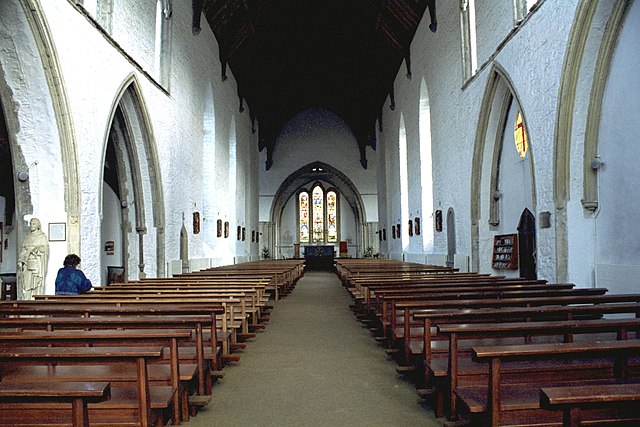Graiguenamanagh
Town in County Kilkenny, Ireland From Wikipedia, the free encyclopedia
Town in County Kilkenny, Ireland From Wikipedia, the free encyclopedia
Graiguenamanagh or Graignamanagh (Irish: Gráig na Manach, meaning 'valley (or village) of the monks')[2] is a town on the River Barrow in County Kilkenny, Ireland. Part of the settlement, known as Tinnahinch, is on the County Carlow side of the river, and Carlow County Council refers to the whole village as "Graiguenamanagh-Tinnahinch".[3][4] Also combined for census purposes, as of the 2022 census, Graiguenamanagh-Tinnahinch had a population of 1,506 people.[1] The town is in a townland and civil parish of the same name.[5]
Graiguenamanagh is located at the foot of Brandon Hill and is home to Duiske Abbey, the largest of the thirty-four mediaeval Cistercian abbeys in Ireland.
Evidence of ancient settlement in the area include an ecclesiastical enclosure and holy well sites in the townlands of Graiguenamanagh and Tinnahinch.[6][7] St. Caelán reputedly founded a monastery at Tinnahinch during the 6th or 7th century.[8]
Also located in the area are the ruined remains of the early Christian church of Ullard, founded by Saint Fiachra in the seventh century. Several miles downstream from Graiguenamanagh are the ruins of an ancient monastic establishment at St Mullin's.[citation needed]
| Year | Pop. | ±% |
|---|---|---|
| 1821 | 1,546 | — |
| 1831 | 2,130 | +37.8% |
| 1841 | 2,248 | +5.5% |
| 1851 | 1,710 | −23.9% |
| 1861 | 1,320 | −22.8% |
| 1871 | 1,272 | −3.6% |
| 1881 | 1,172 | −7.9% |
| 1891 | 973 | −17.0% |
| 1901 | 852 | −12.4% |
| 1911 | 844 | −0.9% |
| 1926 | 799 | −5.3% |
| 1936 | 845 | +5.8% |
| 1946 | 1,064 | +25.9% |
| 1951 | 1,076 | +1.1% |
| 1956 | 1,366 | +27.0% |
| 1961 | 1,244 | −8.9% |
| 1966 | 1,177 | −5.4% |
| 1971 | 1,303 | +10.7% |
| 1981 | 1,532 | +17.6% |
| 1986 | 1,485 | −3.1% |
| 1991 | 1,395 | −6.1% |
| 1996 | 1,374 | −1.5% |
| 2002 | 1,435 | +4.4% |
| 2006 | 1,376 | −4.1% |
| 2011 | 1,543 | +12.1% |
| 2016 | 1,475 | −4.4% |
| 2022 | 1,506 | +2.1% |
| [9][1] | ||

Based on an earlier settlement, much of Graiguenamanagh developed around the early 13th-century Duiske Abbey.[11] The abbey, which takes its name from the river Duiske (Blackwater) which joins the Barrow here, was founded by William Marshall in 1204 and was suppressed by Henry VIII in 1536.[12] Some remains of the monastery exist to the rear of the houses that line the east side of Lower Main Street.
The abbey's large "Early English" gothic church was restored in the 1980s,[13] and it is now the Catholic parish church in Graiguenamanagh.[14] In its northern aisle is a model which shows the monastery as it was in the fourteenth century.[citation needed]
The River Barrow, historically a transport route, was developed as a commercial navigation during the 18th century.[15] Graiguenamanagh Bridge, a seven-arched limestone bridge spanning the River Barrow, was built in 1764.[16]
Graiguenamanagh served as a base for commercial barges operating on the river until barge traffic ceased in 1959.[15] These barges were later replaced by pleasure craft.[citation needed]
The town is located on the R705 regional road. Kilbride Coaches operate a route linking it to Kilkenny via Gowran.[17]

Watersports, angling,[18] walking and cycling (including on the Barrow towpath) are common activities in the Graiguenamanagh area.[citation needed] The Barrow's aquatic facilities include fishing, swimming, kayaking, and canoeing. The South Leinster Way, a long-distance trail, runs across the Barrow Valley and nearby Brandon Hill.[19][18]
The local Gaelic Athletic Association club, Graignamanagh GAA, fields teams in Gaelic football and hurling competitions and is based in Dr Tierney Park in the town.[20] The town is also home to an athletics club and a soccer club.[citation needed]
There is a series of statues of monks in Graiguenamanagh, including several which depict the activities traditionally carried out by the Cistercian monks of Duiske Abbey.[citation needed] There is also a public library in the center of town.[21] The Abbey Centre, beside the library, is home to an art gallery and a small museum.[citation needed]
Seamless Wikipedia browsing. On steroids.
Every time you click a link to Wikipedia, Wiktionary or Wikiquote in your browser's search results, it will show the modern Wikiwand interface.
Wikiwand extension is a five stars, simple, with minimum permission required to keep your browsing private, safe and transparent.